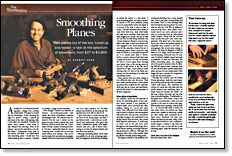Smoothing Planes
New planes out of the box, tuned up and tested-a look at the spectrum of smoothers, from $27 to $3,800
Synopsis: Garrett Hack tunes and tests 10 smoothing planes to see how they perform in this extensive review. He cites the best uses for each category of plane, and he lists the weight, length, blade thickness, and manufacture information, along with detailed comments for each plane. The ones he evaluated represent various constructions, functions, and cost, and fall into three categories: wooden, metal, and combination. He tested them on softwood and hardwood, and on calm grain and “ornery” grain The best planes, he says, have plenty of mass; wide, thick irons; short, thick bodies; and tight throat openings.
A Stanley No. 604 Bedrock smoothing plane—vintage 1910—is always on my bench. The plane is a handy size for smoothing a board, shooting the edge of a drawer, cutting a tapered leg and many of the other daily planing tasks. I have other old smoothers, Norrises and Spiers, heavy planes I keep tuned to take whisper-thin shavings. Most of my planes—not just the smoothers—are old. But when I demonstrate these tools in my classes, invariably I am asked which new smoothing plane I would buy. Not really knowing how to answer, I decided to examine a range of new smoothers.
Even though I limited my selection to western, cut-on-the-push-stroke style planes, the variety of smoothers I tried was astoundingly wide. The selection isn’t exhaustive, but the ones I picked run the gamut in terms of their construction, their function and how much they cost. One is made of beech, another of laminated nickel. One has a replaceable blade the size of a shaving razor; another has an iron that could anchor your rowboat. One can be had for under $30 and delivered overnight; another will set you back some $3,800 and cost you a year’s patience, too. Yet these planes were all built to do the same job. My question was, how well do they do it?
I gave each plane a quick tune-up (see the story on the facing page), and then I put them to work. I used each one on softwoods and hardwoods, calm grain and ornery. I planed pine, poplar, curly maple, abrasive teak and a pile of cherry wainscoting to see how the planes behaved and how their irons held up.
Although smoothing planes can be used successfully for all sorts of planing tasks, they are designed to perform best at taking an already flat surface to a fine finish. A good smoothing plane can create a surface as smooth as if it were polished, giving wood an unmatchable clarity and depth in a fraction of the time it takes to sand or scrape. The best smoothers have plenty of mass, wide, thick irons, short, thick bodies and tight throat openings. Mass keeps the plane hugging the surface, and just as with old cast-iron woodworking machines, lots of mass dampens vibration and gives stability to the cutter. A thick iron remains stiff and engaged in the wood despite resistance for the smoothest, chatter-free cut.
From Fine Woodworking #136
For the full article, download the PDF below:
Fine Woodworking Recommended Products

Veritas Precision Square

Tite-Mark Marking Gauge

Marking knife: Hock Double-Bevel Violin Knife, 3/4 in.






















Log in or create an account to post a comment.
Sign up Log in